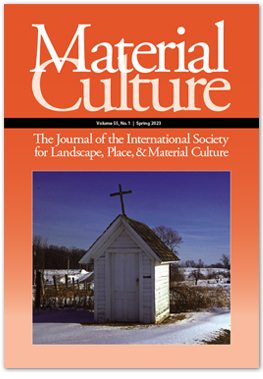Material Culture Culture is printed two times a year for members of PAS:APAL. It is abstracted and indexed in: JSTOR, ProQuest, History and Life, Historical Abstracts, GeoAbstracts, and the MLA International Bibliography. You may download a PDF of the table of contents of the current issue here. The Spring 2023 issue of Material Culture includes:
 Postcards from the Past: Mining eBay for Research Material
Postcards from the Past: Mining eBay for Research Material
By H. Jason Combs, Community and Regional Planner, Miller & Associates
Abstract: In recent decades, scholars have discussed eBay and how its selling platform has altered basic exchange patterns. Numerous other studies have examined the value of postcards. This study combines those two ideas and reveals how eBay can be used to acquire postcards — primary data — to conduct research. One goal is to discuss eBay and provide a snapshot of its value as a research archive. The other goal is to evaluate postcards and how they provide research opportunities. To accomplish these goals weekly eBay samples were collected during 2021 and the overall number of postcards was tallied, as was the number of real photo postcards. Unique searches for postcards from Alabama, Nebraska, Ohio, and Vermont that contain specific themes were also completed. Searches were broadly divided into two popular categories — natural events and signs of progress and development. Findings reveal that eBay has brought to market an amazing volume of postcards and potential research possibilities are near limitless.
Cogswell Temperance Fountains: The Failure of a Well-Intentioned Idea
By Anne Beamish, Department of Landscape Architecture and Regional & Community Planning, Kansas State University
Abstract: This article explores the philanthropic work of Henry D. Cogswell, a 19th-century San Francisco dentist and temperance advocate who was largely unsuccessful in his effort to permanently place his donated drinking fountains in cities across the U.S. His gifts were soon so despised that they were often removed from the streets and parks of American cities. Though public drinking fountains were considered a desirable amenity, many cities rejected Cogswell’s offer, and those that did accept them quickly regretted their decision. Of the fountains that were built, most were vandalized, destroyed, or removed. There were multiple reasons for the hostility. Not only did cities object to his aesthetic taste, they resented that they still had to make significant financial contributions to the “free” fountain, they suspected Cogswell’s motives, and many objected to what they considered to be Cogswell’s condescending message. Of the over 50 drinking fountains Cogswell donated to cities, only five survive today. But some good did come of it. The unhappy experience made cities more aware of the need for public drinking fountains and motivated them to develop policies or establish art commissions to prevent donations from being accepted with minimal scrutiny in the future.

“Mr. and Mrs. Speakeasy.” Source: Lewis, Mary E. in Collaboration with Dorothy Dignam. 1947. The Marriage of Diamonds and Dolls. New York: H.L. Lindquist.Figure 1. “The Drunkard’s Progress,” 1846, shows an archway with the nine steps of a drunkard’s progress, beginning with a man in fancy dress having “a glass with a friend” and then his gradual decline that included poverty, disease, criminal activity, and his eventual “death by suicide.” E.B. & E.C. Kellogg. The drunkard’s progress / Kelloggs & Thayer, 144 Fulton St. N.Y. ; E.B. & E.C. Kellogg, 136 Main St. Hartford, Conn. ; D. Needham, 223 Main St., Buffalo. , ca. 1846. Hartford: EB & EC Kellogg, June 15. Photograph. Courtesy of the Library of Congress. https://www.loc.gov/item/2002706811/.
Revisiting Roadside Chapels in Wisconsin’s Belgian Culture Region
By John A. Cross, Department of Geography, University of Wisconsin Oshkosh
Abstract: Four decades ago, two cultural geographers and a landscape architect described Wisconsin’s Belgian ethnic landscape, the nation’s largest rural concentration of persons of Belgian ancestry, noting its distinctive architecture and religious heritage. The presence of small roadside votive chapels had long been noted, yet the geographers lamented that they might disappear over time. The landscape architect noted that there were “only a dozen remaining chapels” and there were none “under construction.” This paper revisits the findings of these scholars and looks at the contemporary status of these chapels. Today there are as many roadside chapels as there were in the 1980s, including historic chapels, those relocated to cemeteries, plus at least five new chapels erected this century. Their continuing presence, promotion by the Belgian Heritage Center, and interest and publicity by a local religious leader ensures that they remain an enduring sacred feature on the Belgian cultural landscape of northeast Wisconsin.
